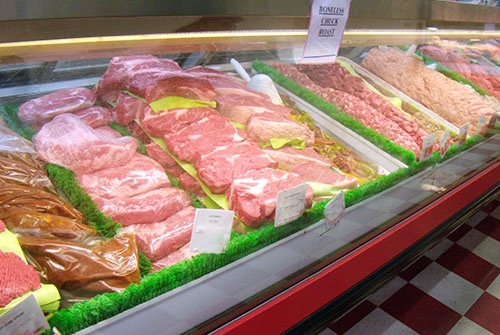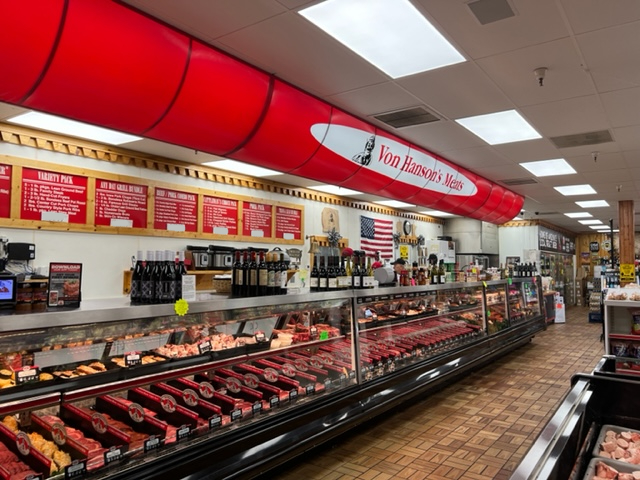Leading Factors to Patronize Bagley Farms Meat Market Edwardsville IL for Costs Meats
Leading Factors to Patronize Bagley Farms Meat Market Edwardsville IL for Costs Meats
Blog Article
Reveal the Art of the Butcher's Cut in a Modern Meat Market
In the ever-evolving landscape of modern-day meat markets, the butcher's cut has actually transcended its typical origins, merging age-old craftsmanship with modern techniques. bagley farms meat market edwardsville il. Today's butchers are not just processors of meat; they are well-informed artisans who stress sustainability and honest sourcing. Their know-how in picking and preparing cuts tailored to specific cooking demands uses an unequaled dining experience. What absolutely establishes the contemporary butcher apart is their ability to build a deeper link in between consumers and the beginnings of their meat. Exactly how do these masters balance custom with development, and what implications does this have for the future of meat intake?
Development of Butchery Techniques

The mid-20th century saw butchery strategies better improved by scientific insights into muscular tissue biology and meat aging, boosting both inflammation and taste. Developments like vacuum product packaging and refrigeration expanded product shelf-life, allowing butchers to diversify offerings and boost quality assurance. This period also noted the increase of specific equipment, such as band saws and meat slicers, which raised accuracy and effectiveness in meat processing.
Electronic systems now help in monitoring animal provenance and maximizing cuts to meet details customer choices. Additionally, a renewal in artisanal butchery has emerged, mixing traditional abilities with modern-day knowledge to provide to customers seeking honest and lasting meat options.

Understanding Meat Cuts

Comprehending the complexities of meat cuts is important for both butchers and customers looking for high quality and value. Each cut comes from a different component of the pet, giving one-of-a-kind tastes, structures, and cooking methods. Proficiency of these distinctions not only enhances cooking experiences however also optimizes the energy of each carcass. For butchers, accurate cuts reflect ability and respect for the craft, ensuring marginal waste and ideal yield.
The main groups of meat cuts include primitive, sub-primal, and retail cuts. Butchers then break these down better into sub-primal cuts, prior to finally creating retail cuts readily available to consumers, like ribeye or tenderloin.
Recognizing muscle structure is critical; muscle mass made use of more often by the pet tend to be tougher and are best fit for slow-moving cooking techniques, while less-used muscular tissues, like those found in the loin, are much more tender and perfect for grilling or roasting. Familiarity with these differences encourages customers to make informed options, improving their cooking endeavors.
Choosing High Quality Meat
Selecting the ideal meat entails even more than simply selecting an aesthetically enticing item from the display screen. The art of picking top quality meat needs a discerning eye and knowledge of particular characteristics that represent freshness and excellence. To start with, focus on the shade; beef must have a brilliant, cherry-red shade, while lamb ought to exhibit a soft pink tone, and pork a light pink. This indicates the meat is fresh and hasn't been exposed to oxygen for also my company lengthy.
Second of a fantastic read all, think about the marbling, which describes the white streaks of fat within the muscle. Correct marbling is an essential indicator of inflammation and flavor, as it thaws during food preparation, improving the meat's juiciness. Bear in mind, higher marbling frequently associates with premium top quality cuts, such as USDA Prime.
Structure is an additional important factor; meat needs to feel strong to the touch, not slimy or excessively soft. Additionally, bear in mind the scent. Fresh meat must have a tidy, neutral smell, cost-free from any type of sour or repulsive odors.
Combining Cuts With Food Preparation Techniques
Successfully pairing cuts of meat with the suitable food preparation approaches is essential for accomplishing optimum flavor and texture. These techniques boost the meat's natural flavors and guarantee a juicy surface.
On the other hand, harder cuts like brisket and chuck roast are abundant in collagen, which damages down into gelatin when cooked slowly. These cuts are suitable for braising or slow roasting, enabling the meat to soften with time and establish deep, intricate tastes. Cuts such as short ribs and pork shoulder fare well with slow-cooking methods, where expanded cooking times change their durable appearances into succulent recipes.
Lamb shanks and oxtail, which call for extended cooking to tenderize, are perfect prospects for cooking or sluggish simmering. These methods coax out abundant, passionate flavors while maintaining dampness. By recognizing the special attributes of each cut, chefs and home chefs alike can raise their culinary creations, ensuring each recipe is both satisfying and memorable.
The Butcher's Duty Today
Browsing the developing landscape of the modern meat market, the butcher's duty today prolongs past plain prep work of cuts. Contemporary butchers are cooking craftsmens, educators, and supporters for sustainable methods. They bridge the void between the ranch and the fork by making sure ethical sourcing, recognizing animal husbandry, and focusing on transparency in the supply chain. This change reflects the expanding consumer need for quality over amount, where provenance and animal well-being are paramount.
In enhancement to crafting precise cuts, butchers currently involve directly with clients, offering cooking recommendations and customizing selections to fit individual requirements and choices. Their expertise in meat aging, marbling, and flavor accounts encourages consumers to make educated choices, enhancing their culinary experiences. This individualized solution exemplifies the butcher's progressing duty as a relied on advisor in the kitchen area.
In addition, butchers are pivotal in reducing waste, using entire pets to create diverse products such as sausages and stocks - bagley farms meat market edwardsville il. This detailed strategy not only respects the click here to find out more animal however likewise straightens with modern sustainability objectives. This way, the modern butcher symbolizes both custom and advancement, adjusting to an ever-changing market while maintaining the virtuosity and honesty of their craft

Verdict
The modern butcher's craft elaborately weaves conventional strategies with modern-day advancements, emphasizing lasting methods and ethical sourcing. Proficiency in comprehending diverse meat cuts and top quality signs encourages butchers to supply informed referrals, lining up specific cuts with optimum cooking approaches. This experience not only boosts culinary experiences yet likewise strengthens the connection in between consumers and the beginnings of their food. By honoring historic methods while welcoming contemporary needs, the butcher's duty remains essential in today's sophisticated meat market.
Report this page